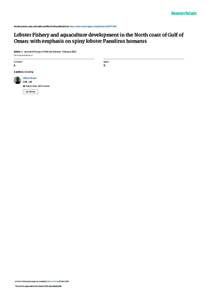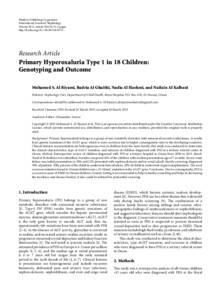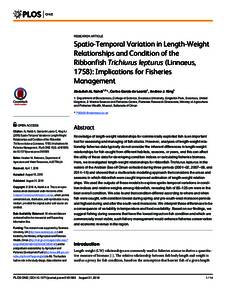Document
Potential of microsatellite markers for genetic assessment of scalloped spiny lobster (Panulirus homarus) populations in Al Sharqiyah Governorate and their application in specie’s fishery management.
Identifier
DOI: 10.53541/jams.vol29iss2pp42 - 50
Source
Journal of Agricultural and Marine Sciences (JAMS), v. 29, no. 2, p. 42-50.
Other titles
(Panulirus homarus) في محافظة الشرقية وتطبيقها في إدارة مصائد الأسماك إمكانات عُلامات التوابع الدقيقة في التقييم الوراثي لتجمعات جراد البحر الشوكي
Country
Oman
City
Muscat
Publisher
College of Agricultural and Marine Sciences, Sultan Qaboos University.
Gregorian
2024-09-17
Language
English
English abstract
Spiny lobster is one of the highest-priced seafood worldwide. Its fishery contributes well to the
country's income and is considered one of the important export items to other countries. However, its annual
catch declined sharply. Studying the stock is important for proper fishery management because stock res
ponds differently to overexploitation and adaptation, therefore different stocks need different conservation
plan. In this study, the genetic diversity and population differentiation of 50 P. homarus (the most present
spiny lobster subspecies in Oman) from two regions (Al-Ashkharah and Masirah) of Al Sharqyah gover
norate were studied using 49 microsatellite markers. The results showed that P. homarus from the two sites
are genetically similar based on low Fst (0.009), AMOVA test (1% variation). In addition, they are admixed
as it is shown by DAPC (Discriminate Analysis of Principal Component) and by the phylogenetic tree. In
conclusion, P. homarus from the two sites can be considered as a single stock, therefore the same fishery
management and conservation strategy can be used to manage the spiny lobster fishery in Al Sharqyah go
vernorate. More studies with a larger sample size are necessary to support our findings.
ISSN
Online: 2410-1079
Print: 2410-1060
Arabic abstract
يعتبر جراد البحر الشوكي من المأكولات البحرية الأعلى سعرًا في جميع أنحاء العالم. كما تساهم مصائده بشكل جيد في دخل البلاد، وتعتبر أحد أهم العناصر المصدرة إلى الدول الأخرى. ولكن كمية الإنزال السنوية لهذا النوع انخفضت بشكل حاد. ومن المعروف أن دراسة المخزون المرتبط بأي نوع مهم جدًا للحصول على إدارة سمكية ناجحة، وذلك لأن كل مخزون يتأثر بشكل مختلف بالاستغلال المفرط ويتأقلم بشكل مختلف في البيئات الجديدة، وبالتالي قد يحتاج إلى خطة حفظ مختلفة. في هذه الدراسة، تمت دراسة التنوع الجيني والتمايز السكاني لنوع جراد البحر الشوكي الأكثر شيوعًا في عمان (P. homarus) باستخدام 49 علامة من التوابع الدقيقة. أظهرت النتائج أن جراد البحر الشوكي من منطقتي الأشخرة ومصيرة متشابه جينيًا بناءً على قيمة منخفضة لمعامل التمييز الجيني (Fst = 0.009) ونسبة اختلاف بين الموقعين بلغت (%1). بالإضافة إلى ذلك، أظهرت النتائج تشابهًا جينيًا كبيرًا بين الأفراد من الموقعين، مما يشير إلى أن جراد البحر الشوكي من المنطقتين ينتمي إلى نفس المخزون. وبناءً على ذلك، يمكن اعتماد نفس استراتيجية إدارة المصائد لإدارة صيد جراد البحر في محافظة الشرقية. هناك حاجة إلى المزيد من الدراسات مع عدد أكبر من العينات لدعم هذه النتائج.
Category
Journal articles



